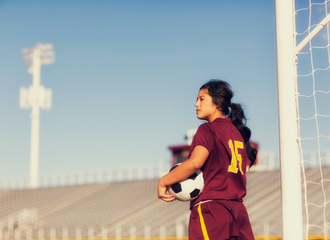Written by: Samantha DeCaro, PsyD (she/her)
Director of Clinical Outreach and Education, The Renfrew Center
Eating disorders can affect anyone, but certain populations experience an elevated level of risk – like college athletes. In this post, we look at the reasons college athletes are more at risk and what they can do to manage or overcome the challenges.
College creates the perfect storm of biological, social, and cultural factors that contribute to the development and maintenance of eating disorders and disordered eating. Transitions, stressors, and change can often trigger the onset of an eating disorder, putting college students at an increased risk considering the unique challenges they face developmentally, socially, and academically.
Why College Athletes Have an Even Greater Risk for Eating Disorders
Research suggests that athletes who participate in a sport associated with a ‘lean aesthetic’ further elevates the risk for eating disorders and disordered behaviors, especially for athletes who identify as female.
College gymnasts, divers, rowers, ballet dancers, track runners, cyclers, and figure skaters who experience pressure from self and others to achieve the sport’s ‘body ideal’ may find themselves turning to unhealthy and dangerous behaviors to manipulate their weight, build, and shape. These behaviors can be driven by the belief that a leaner physique will improve athletic performance or fueled by the qualifications associated with various weight-class sports.
Behaviors such as restriction, bingeing, purging and over-exercise can eventually result in medical, social, and psychological issues, including the onset of a potentially fatal eating disorder. Research suggests that issues around food, exercise, and body image can linger for these athletes for years after the competitive sport ends.
Why Athletes Are So Hard to Diagnose
Given that athletes are often expected to engage in intense training and conditioning programs to improve strength and endurance, compulsive over-exercise can easily be minimized or even praised by coaches, teammates, and other professionals.
To complicate matters, the more well-known assessment tools used to screen for eating disorders will likely not capture the unique behaviors and thoughts athletes experience around food, body image, and exercise.
For example, the SCOFF questionnaire (Morgan, Reid and Lacey, 1999) consists of 5 questions, none of which inquire about over-exercise or purging.
The Eating Disorder Inventory 3rd Edition (Garner, 2004) and the Eating Disorder Examination Questionnaire (Fairburn & Beglin, 2008) were not designed for athletes, do not adequately assess for over-exercise, nor do they reveal the athlete’s problematic attitudes, motivations, or emotions that may be driving their disordered behaviors.
It is crucial that students, coaches, and other support persons on college campuses learn to recognize the signs and symptoms of eating disorders experienced by athletes so that they can access the support they need and deserve.
10 Signs & Symptoms of Eating Disorders in Athletes
Disordered eating occurs on a spectrum, so behaviors and attitudes around food and weight may range from mild to severe in both severity and frequency.
- A desire to achieve the ideal athletic look may result in symptoms such as restricting, as well as forms of purging, such as over-training or over-exercise.
- Signs of over-training may include exercising much longer, much more frequently, and much more intensely than what is typically recommended for the sport, coupled with extreme anxiety and guilt if they are unable to train.
- Someone struggling with over-exercise might also insist on exercising despite having an injury or an illness.
- Body dissatisfaction may manifest as frequent comments about weight, shape, and size, as well as constant physical comparisons between self and other players in the sport.
- Athletes struggling with eating pathology may also latch on to an enduring and rigid belief that continued fat loss will improve their strength, stamina, or performance in some way.
- Restriction might take the form of fad diets, fasting, cleanses, or elimination of entire food groups without any medical rationale.
- Other forms of purging might include self-induced vomiting, or the use or abuse of laxatives, diet pills, or diuretics.
- Drive for a lean but highly muscular build might include abuse of supplements and/or steroids.
- To combat fatigue from prolonged disordered eating, an athlete might also turn to the abuse of caffeine, pre-workout supplements, or stimulants.
- Eating disorders rarely travel alone, so an athlete engaging in disordered eating might also be struggling with depression, mood swings, anxiety, sleep issues, or other mental health concerns.
Medical and Psychological Consequences
An athlete does not have to be diagnosed with an eating disorder to experience the negative consequences of disordered eating. Given that all athletes require sufficient caloric intake to fuel their training and daily demands, athletes who restrict their intake, over-train, binge, and/or purge are at risk for various medical, psychological, and social complications.
From a medical perspective, the “Female Athlete Triad” is a cluster of issues characterized by fatigue, decreased bone density, and menstrual problems. The Triad can result in various other health concerns, such as cardiovascular disease and physical injuries (Mountjoy et al., 2014). Athletes might also experience “Relative Energy Deficiency Syndrome” (RED-S), a condition potentially resulting in systemic medical issues, weight loss, injuries, mental distress, and impaired athletic performance (Tayne, Hruber, Hutchinson, & Mountjoy, 2019).
Signs of an eating disorder can also include avoidance of the dining hall, isolation from friends and roommates, reduced interest in activities outside of training, as well as difficulty thinking clearly and concentrating in class.
10 Tips for College Athletes Struggling with An Eating Disorder
- Reach Out for an Assessment. If you think you might be struggling with an eating disorder or disordered eating, reach out to your medical providers and/or your university’s counseling & health centers for screening and assessment. The sooner you can get the right level of support, the better.
- Identify Supports. Take inventory of the supportive people in your life and consider sharing your struggles with someone you trust. Your support network might consist of family, friends, teammates, mental health and/or medical providers. Eating disorders thrive in isolation; admitting out loud that you need support can be a powerful step on the path to healing.
- Give Yourself Permission to Prioritize Mental Health. Your role as a student athlete is part of who you are, yet it can easily feel like your entire identity. It can be difficult to prioritize your own wellbeing. Remember that you have permission to focus on your mental and physical health above all else. An untreated eating disorder can rob you of so many experiences in college, both in your courses and in your sport. Draw inspiration from the bravery of well-known athletes who have prioritized their mental health despite undue pressure to compete. Explore your options, such as taking medical leave from school, if necessary. You have permission to walk away from something that no longer serves you mentally, spiritually, or physically.
- Identify Values & Explore Ambivalence. An eating disorder can interfere with living a life aligned with your values. It can be helpful to first identify what is most meaningful to you and what you ultimately want to gain from your college experience. Consider all the pros and cons of change versus all the pros and cons of staying the same. How might recovery improve your college experience athletically, socially, physically, and mentally?
- Challenge Beliefs Rooted in Anti-Fatness: Take time to learn more about the ways in which the diet and fitness industries profit from anti-fat attitudes. Look for evidence that challenges those beliefs instead of latching on to information that confirms them. Seek out and follow the work of fat positive athletes and activists to challenge the internalized belief that an athletic body must look like an aesthetic “ideal” to perform.
- Seek Out Supportive Teammates. Spend time with supportive teammates and create boundaries with those who normalize disordered eating or pressure you to change your body. Consider clearly communicating to your teammates how you want to be supported, including what makes it even harder for you to heal.
- Shift Your Focus. If you notice thoughts about weight, shape, or appearance pop up, mindfully shift awareness to what your body can do. Foster appreciation and gratitude for the function of your body, as well as your (and your teammates’) inner traits, such as cooperation and confidence.
- Ditch Over-Exercise for Embodying Activities. Experiment with non-competitive ways of moving your body that bring you joy and deepen your connection with your body.
- Listen to Your Body. To improve your relationship with your body, treat it with respect and kindness by honoring its cues for rest and relaxation. Allow food to be a source of fuel, as well as a source of culture, connection, and pleasure.
- Help Others Help You: An individual therapist can help you navigate difficult conversations with family, friends, roommates, teammates, and coaches, as well as provide psychoeducation to your support system. Talk to your therapist about the possibility of joint sessions and collateral contacts so that the people in your life can learn how to best support you.
Conclusion
Athletes experience unique challenges in the college setting, and are at elevated risk of eating disorders, disordered eating, and body image issues in aesthetic/lean sports compared to non-athletes. The signs and symptoms of eating pathology can get lost in the shuffle when many of these behaviors and beliefs are normalized and praised in sports. Eating disorder symptoms can impact an athlete’s ability to perform athletically, while also harming their mental, physical, academic, and social wellbeing. Coaches and teammates can be powerful supports if they understand the underlying factors that contribute to these issues, value the overall wellbeing of each athlete, and recognize the signs when someone is struggling. Help is available, and athletes should be encouraged and supported whenever they choose to pursue it.
Sources:
- Intl J Eating Disorders – 2018 – Chapa – The Athletes’ Relationships with Training scale (ART): A self-report measure of unhealthy training behaviors associated with eating disorders
- Intl J Eating Disorders – 2021 – Thompson – Psychosocial predictors of eating classification in female athletes From collegiate sport to retirement
- Intl J Eating Disorders – 2022 – Chapa – Eating‐disorder psychopathology in female athletes and non‐athletes: A meta-analysis
- Intl J Eating Disorders – 2020 – Scott – Teammate influences psychological well‐being and athletes eating and exercise psychopathology: A moderated mediation analysis



